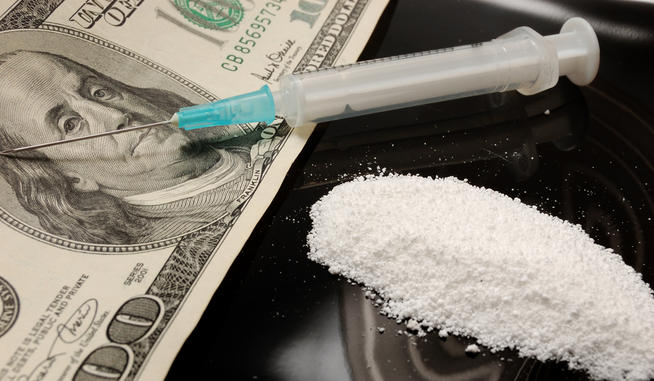
In the past few months, an uptick of usage has caused many to draw back the curtain into a world that many have long ignored. Where is it coming from?
By Curt Cramer
Decriminalization of marijuana has led to lots of changes in the United States. Taxation, medical breakthroughs, political shifts… all seemingly good natured.
But there possible is a side effect now taking a turn for the worst, fueled by legalization of marijuana on one end, and slavery to pharmaceutical needs on the other. Heroin – the drug stigmatized in the past with visions of ghastly, tortured humans at the lowest end of the social spectrum – has began to feed on all types of people, especially those finding themselves at a crossroads of dependence on pain medication that is so liberally distributed by doctors, and the financial dismay of having to afford the addiction once the prescriptions expire. In recent data collection reported by the federal government, use of the drug in the United States increased 79 percent between 2007 and 2012.
Where pain medications across the United States can range from $30 a pill and up, heroin is flooding into many sections of the country at prices of $20 a “ticket” (one dose) and lower, and is even more potent in many cases. Through the northeast especially, this is becoming a serious issue. In New Jersey alone, it is common in some places to find some of the purest heroin at only $5 a bag. As of recent, law enforcement there has been encountering scarily large numbers of overdoses, with heroin that can be as pure as 60%, whereas 45 years ago it was a majority of 4 to 8 percent, according to state documents.
Though prescription deaths still currently outnumber those of the heroin trade, these shocking numbers still beg the question: where is it all coming from?
The clues are already there. With the dwindling prices of illegal Marijuana crop in Mexico going from $100 a kilogram to $25, farmers are turning to more lucrative means to feed both their families, and supply the cartels who pay them. These farmers of the infamous “Golden Triangle” region of the Mexican Sinaloa, have reported they no longer plant marijuana, but the highly demanded producer of opiates instead – the poppy flower.
In a recent Washington Post article, writer Nick Miroff outlined that authorities from this region all the way to deep South American countries are finding huge scale operations where they have never been seen before, almost exclusively all producing heroin traveling northward to users in the United States. According to the DEA, 90% of US heroin comes from Mexico and Columbia, the latter being the former larger distributor until recently. U.S. authorities seized 2,162 kilos of heroin last year, a record amount, up from 367 kilos in 2007 in reports from Department of Justice officials.
“There’s no other way to make a living here”, a Sierra Madre farmer named Silla said. Other farmers agree, seeing their crop of poppies as just another plant amongst the corn, beans, and others they sustain. While those crops bring in negligible amounts of funding, when done right, poppy planting brings in top pay in the region at close to $40 a day. Silla’s operation was cut short last month when aerial surveillance spotted the bright and colorful poppies, and law enforcement eradicated the plot according to Reuters.
As the poppy flowers, the seedpod swells, filled with milky latex sap. Farmhands then slice the seedpod to bleed the pod of the sap that drains onto the surface like blood. Each pod can be sliced several times, and the process takes at least a few weeks. As the sap dries, it hardens and turns brown, and farmhands return to peel off the finished product, rolling it into balls and cake-like formations. Interestingly, they can be stored for extended amounts of time – years in fact. With this, the grower can wait to sell when optimum market conditions are present before selling to cartel labs. Cartels, like Mexico’s largest Sinaloa Cartel, then process the heroin into powders and pastes, and ship it off to dealers.
A kilo of raw opium sap sells at $1,500 wholesale. This is nearly double the price of what it was worth in 2012. Farmers can yield up to 8 kilos of poppy sap in one acre, and that is roughly the amount required to produce one kilo of uncut heroin. It also travels much easier than Marijuana, and is far less detectable. By the time it reaches the US, the same kilo can be worth as much as $60,000 to $80,000.
So, why is heroin so cheap then? With Mexican producers on the rise, much like any marketing expert, they look to expand into new markets to release the product. Reports of cartel heads sending experienced dealers into US cities where no heroin was ever present are heard more and more each day. Even posting dealers outside of Methadone clinics in some spots. Some users even tell of free doses being given to them at parties. The heavy production of heroin worldwide leads to simple supply and demand economics. Though the demand is very high, supply is astounding, and with that fact, saturation of the market remains easy.
With the easing of marijuana regulations in the US, cartels and farmers have diversified quite easily. There is no doubt that we as a country have created this part of the problem in many experts eyes, but changing of marijuana regulation is only a small facet of the larger issue. The root of the evil remains at the opposite end of the spectrum, where pain medication dependence has created a gateway to something that right now has no end in sight, and no plans of slowing down.
-Curt Cramer (@CurtisRemarc)


